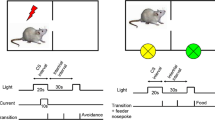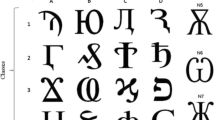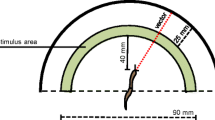Abstract
Three rats were trained on a multiple continuous escape-avoidance with warning stimuli; continuous escape-avoidance without warning stimuli schedule. During the warning stimuli (WS) components, three 5-sec duration, auditory and visual WS were provided (S1, S2, and S3). When the WS order was scrambled, each rat still emitted the majority of its response in the presence of a particular WS. Elimination of avoidance capability (extinction) produced maintained responding to all WS. Presentation of only one WS produced an increase in responding during its presence. Punishment of responding in the presence of a particular WS produced response suppression during that interval and those after but not before it. In general, the data support the “WS as aversive” view (two-factor theory), but also lend support to the “WS as SD” position. Apparently, a WS may serve simultaneously as both a conditioned aversive stimulus and an SD, thus providing a negative reinforcement analogue to the conjunctive conditioned reinforcer and SD functions that stimuli provide in appetitive situations.
Similar content being viewed by others
References
ANGER, D. 1963. The role of temporal discrimination in the reinforcement of Sidman avoidance behavior. Journal of the Experimental Analysis of Behavior, 6, 447–506.
AZRIN, N.H. 1956. Some effects of two intermittent schedules of immediate and non-immediate punishment. Journal of Experimental Psychology, 42, 3–21.
BERGER, D.F., & BRUSH, F.R. 1975. Rapid acquisition of discrete trial lever-press avoidance: Effects of signal-shock interval. Journal of the Experimental Analysis of Behavior, 24, 227–239.
BOLLES, R.C., & GROSSEN, N.E. 1969. Effects of an informational stimulus on the acquisition of avoidance behavior in rats. Journal of Comparative and Physiological Psychology, 68, 90–99.
BOLLES, R.C., & POPP, R.J. 1974. Parameters affecting the acquisition of Sidman avoidance. Journal of the Experimental Analysis of behavior, 1, 315–321.
BOLLES, R.C., WARREN, J.A., JR., & OSTROV, N. 1966. The role of the Cs-Us interval in bar press avoidance learning. Psychonomic Science, 6, 113–114.
BROWN, J.S., & JACOBS, A. 1949. The role of fear in the motivation and acquisition of responses. Journal of Experimental Psychology, 39, 747–759.
D’AMATO, M.R., FAZZARO, J., & ETKIN, M. 1968. Anticipatory responding and avoidance discrimination as factors in avoidance conditioning. Journal of Experimental Psychology, 77, 41–47.
DARDANO, J.F. 1971. Control of concurrent avoidance and appetitive behaviors by an indicator of shock proximity. Journal of the Experimental Analysis of Behavior, 15, 167–180.
DINSMOOR, J.A. 1954. Punishment I: The avoidance hypotheses. Psychological Review. 61(1), 34–46.
DINSMOOR, J.A. 1968. Escape from shock as a conditioning technique. In M. Jones. Miami Symposium on the Prediction of Behavio 1967. Aversive Stimulation. Coral Gables, Florida: University of Miami Press.
EMURIAN, H.H., & WEISS, S.J. 1972. Compounding discriminative stimuli controlling free operant avoidance. Journal of the Experimental Analysis of Behavior, 17, 249–256.
FIELD, G.E., & BOREN, J.J. 1963. An adjusting avoidance procedure with multiple auditory and visual warning stimuli. Journal of the Experimental Analysis of Behavior, 6, 537–543.
FOREE, D.D., & LOLORDO, V.M. 1970. Signalled and unsignalled free-operant avoidance in the pigeon. Journal of the Experimental Analysis of Behavior, 13, 283–290.
GRABOWSKI, J., & THOMPSON, T. 1972. Response patterning on an avoidance schedule as a function of time-correlated stimuli. Journal of the Experimental Analysis of Behavior, 18, 525–534.
GRAEFE, J., & PISACRETA, R. 1977. An integrated circuit shock scrambler. Behavioral Research Methods and Instrumentation. 9(6), 499.
GOLDSTEIN, M.L. 1960. Acquired drive strength as a joint function of shock intensity and number of acquisition trials. Journal of Experimental Psychology, 60, 349–358.
HERRNSTEIN, R.J. 1969. Method and theory in the study of avoidance. Psychological Review, 76, 49–69.
HOFFMAN, H.S., FLESHLER, M., & CHORNEY, H. 1961. Discriminated bar press avoidance. Journal of the Experimental Analysis of Behavior, 4, 309–316.
KAMIN, L. 1956. The effects of termination of the Cs and avoidance of the Us on avoidance learning. Journal of Comparative and Physiological Psychology, 49, 420–424.
KAMIN, L. 1957. The gradient of delay of secondary reward in avoidance learning tested on avoidance trials only. Journal of Comparative and Physiological Psychology, 50, 450–456.
KEEHN, J.D. 1959. The effect of a warning signal on unrestricted avoidance behavior. British Journal of Psychology, 50, 125–135.
KELLEHER, R.T., & GOLLUB, L.R. 1962. A review of positive conditioned reinforcement. Journal of the Experimental Analysis of Behavior, 5, 543–597.
LATTAL, K.A., & GRIFFIN, M. 1972. Punishment contrast during free operant avoidance. Journal of the Experimental A nalysis of Behavior, 18, 509–516.
MAY, M.A.. 1948. Experimentally acquired drives. Journal of Experimental Psychology, 38, 66–77.
MCALLISTER, W.R., & MCALLISTER, D.E. 1962. Post conditioning delay and intensity of shock as factors in the measurement of acquired fear. Journal of Experimental Psychology, 64, 110–116.
MILLER, N.E. 1948. Studies of fear as an acquirable drive: I. Fear as motivation and fear-reduction as reinforcement in the learning of new responses. Journal of Experimental Psychology, 38, 89–101.
MOWRER, O.H. 1947. On the dual nature of learning: A reinterpretation of conditioning and problem solving. Harvard Educational Review, 17, 102–148.
PISACRETA, R. 1980. Intermittent escape schedules and their effect on avoidance. The Psychological Record, 30, 237–250.
PISACRETA, R. 1981a. Multiple schedules of escape and their effects on avoidance. The Psychological Record, 31, 237–253.
PISACRETA, R. 1981b. Multiple schedules of escape-avoidance with sequential warning stimuli. The Psychological Record, 31, 573–587.
POWELL, R.W., & SCHONFELD, L. 1981. Effects of warning signal duration of free-operant avoidance. The Psychological Record, 31, 447–455.
RACHLIN, H. 1966. Recovery of responses during mild punishment. Journal of the Experimental Analysis of Behavior, 9, 251–263.
RESCORLA, R.A., & SOLOMON, R.L. 1967. Two-process learning theory relationships between Pavlovian conditioning and instrumental learning. Psychological Review, 74, 151–182.
SCHOENFELD, W.N. 1969. “Avoidance” in behavior theory. Journal of the Experimental Analysis of Behavior, 12, 669–674.
SIDMAN, M. 1955. Some properties of the warning stimulus in avoidance behavior. Journal of Comparative and Physiological Psychology, 48, 444–450.
SIDMAN, M., & BOREN, J.J. 1957. A comparison of two types of warning stimulus in an avoidance situation. Journal of Comparative and Physiological Psychology, 50, 282–287.
SOLOMON, R., & WYNNE, L. 1954. Traumatic avoidance learning. Psychological Review. 61(6), 353–385.
ULRICH, R.E., HOLZ, W.C., & AZRIN, N.H. 1964. Stimulus control of avoidance behavior. Journal of the Experimental A nalysis of Behavior, 7, 129–133.
Author information
Authors and Affiliations
Rights and permissions
About this article
Cite this article
Pisacreta, R. Free-Operant Escape-Avoidance with Sequential Warning Stimuli II: Effects Of Differential Signal Order Reversal, Extinction, Signal Elimination, and Punishment. Psychol Rec 32, 551–565 (1982). https://doi.org/10.1007/BF03394814
Published:
Issue Date:
DOI: https://doi.org/10.1007/BF03394814




